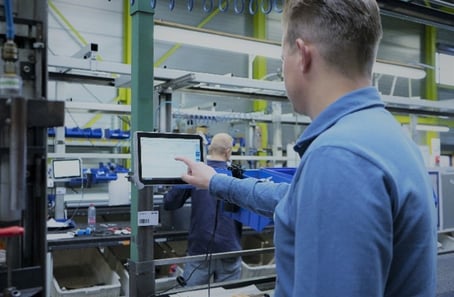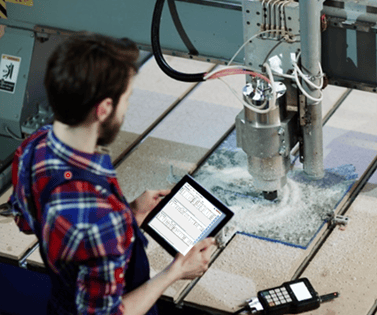This post is a guest blog post provided by Malene Johansen, CSO of our partner NAVEKSA from Denmark.
In June we participated a series of webinars: Business Central Manufacturing Exchange - Shopfloor solutions hosted by NETRONIC. We have been working with NETRONICfor some time. One of the reasons is the great compatibility between our products: Visual Production Scheduler & Shopfloor365. We thank Netronic for the opportunity to write this guest blog which you hopefully find interesting and relatable. Enjoy the reading & thank you for your time.
Make production management efficient and your shopfloor solution digital
 ShopFloor365 visualizes and improves your capacity management. The module gives planning and production the opportunity to efficiently create the optimal job sequences according to priorities and monitoring the execution of the production schedule.
ShopFloor365 visualizes and improves your capacity management. The module gives planning and production the opportunity to efficiently create the optimal job sequences according to priorities and monitoring the execution of the production schedule.
 As an operator, your “paperwork” is done digitally using a shopfloor terminal. Your production order becomes dynamic; all relevant information regarding each production order is available on the terminal. And at the same time, all reporting before, during, and after job execution is entered into the terminal which interferes directly with your Business Central solution. You gain real-time data and optimize your workflow by removing or reducing none-valuable processes: manual handling of production orders and tons of excel spreadsheets.
As an operator, your “paperwork” is done digitally using a shopfloor terminal. Your production order becomes dynamic; all relevant information regarding each production order is available on the terminal. And at the same time, all reporting before, during, and after job execution is entered into the terminal which interferes directly with your Business Central solution. You gain real-time data and optimize your workflow by removing or reducing none-valuable processes: manual handling of production orders and tons of excel spreadsheets.
It gives you the opportunity to improve your business objectives.
Digital transformation in planning and production is needed
The production schedule is made... all your production orders are released for production. An employee responsible for delegating the orders prints the order and delivers it to the right work center. The employee who is to start the order fills out quality documents and writes down information related to the order either on the physically delivered production orders or perhaps on paper, which has been developed and adapted so that it is sufficient to your exact needs.
Or at least needs that you might have had in the past. Now some of the fields are unnecessary; they don’t provide the necessary information as they once did. At the same time, there are other fields that must be filled in before start-up and fields that must be filled in during production, and finally fields that must be filled in when the last item has finished.
Faithfully the employee writes in his best handwriting exactly what the instructions prescribe. On an ongoing basis, another employee goes around collecting data on a new piece of paper to provide this information to the planner, so that the planner can adjust the production if necessary. However, the information is only collected once a day, and therefore it is always with a delay that the planner can take the necessary actions.
It gasps a little in the planner because, of course, it causes problems for customer service and logistics, who now must warn the customer about the delay and make a rebooking of transport. What else does this mean for the other products?
The employee who has collected data in production sits down to enter Business Central. Material usage and quantity of finished goods with item tracking. So many numbers need to be read and entered. Every now and then, it can be difficult to decode the many different types of handwriting. I also hit a bit next to the key, so instead of 5, it became 6... which then became 6000 pieces instead of 5000 pieces. So now my stock doesn't match, but I didn't discover it myself.
The benefit of digital transformation
Imagine if we had a system that could help us with direct feedback and completion of the order.
 A terminal in production that can display the order sequence of a machine or work center. A terminal that can allow you as an operator to open your production order in production and from there get information as well as make entries about material usage and quantity produced with item tracking.
A terminal in production that can display the order sequence of a machine or work center. A terminal that can allow you as an operator to open your production order in production and from there get information as well as make entries about material usage and quantity produced with item tracking.
The system could report stops, breaks, and discarded items. View relevant drawings or instructions without having to physically store them close to the machine. In case of the need to adjust the order sequence, this could also be easily done by setting priorities. Maybe I'm even running two or more orders at the same time, then I'd like to be able to start the processing time at the same time.
 Imagine if we could stop the many coordinating emails and calls and reduce our use of paper-based solutions.
Imagine if we could stop the many coordinating emails and calls and reduce our use of paper-based solutions.
Imagine if it were simple and digital. Imagine if the system spoke directly into our business management system so that all relevant stakeholders could follow, and act based on what we do here and now in production.
See that would be valuable to the company, the customer, and to a very high degree the individual employee.
The solution is called ShopFloor365 and is delivered by NAVEKSA A/S. Please visit our website to read more about features & functionalities and watch our short presentation: ShopFloor365
On behalf of NAVEKSA A/S – Malene Johansen, CSO, mjo@naveksa.com

